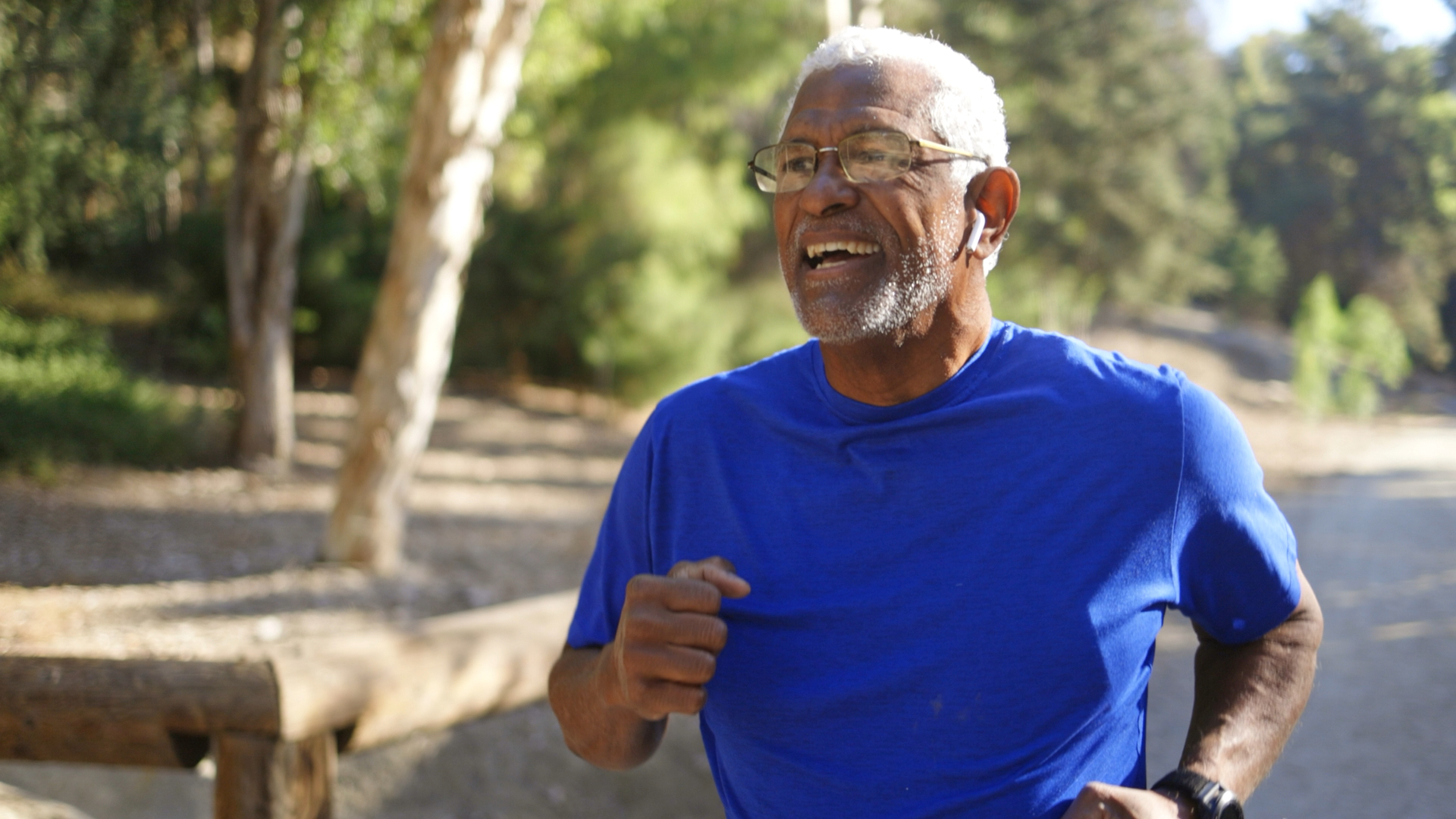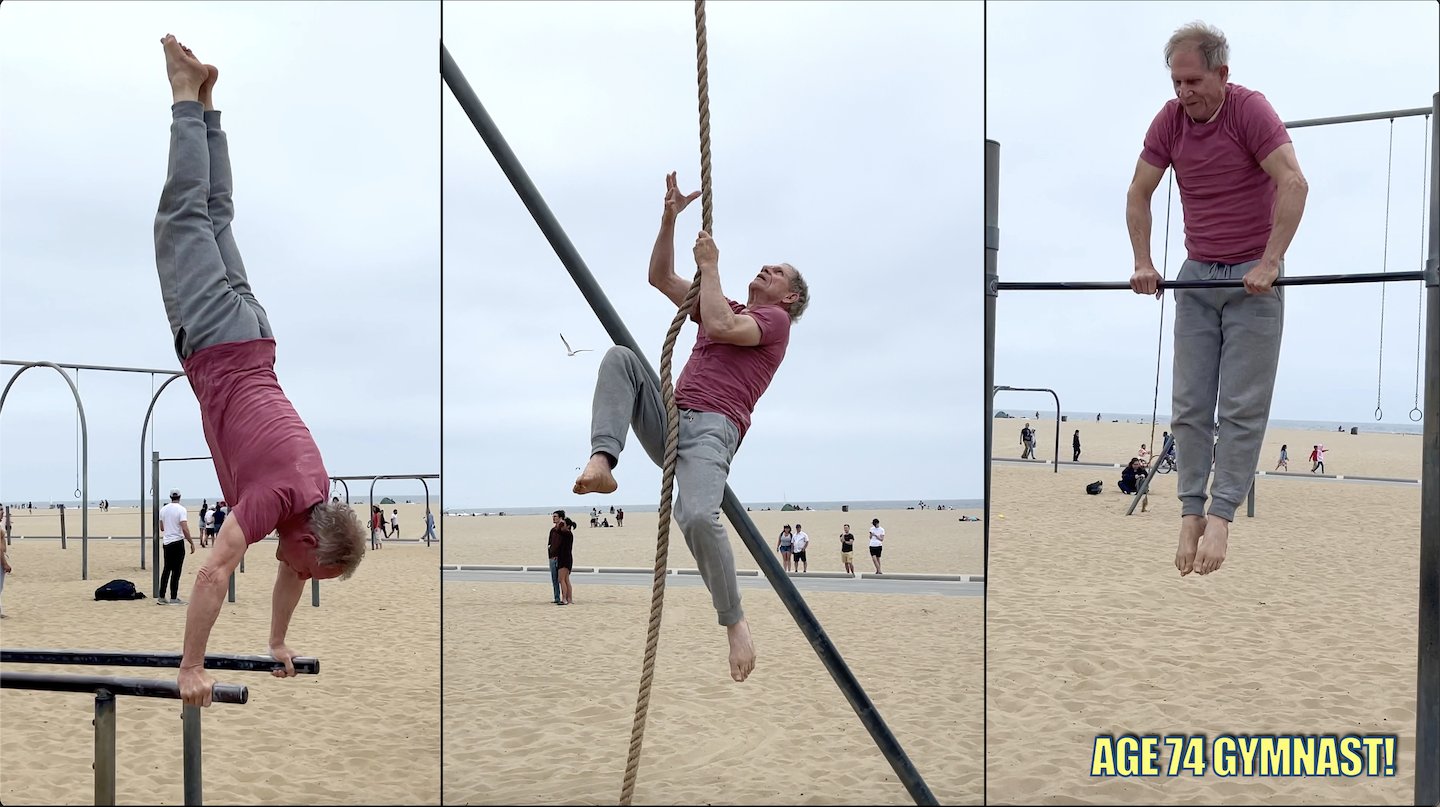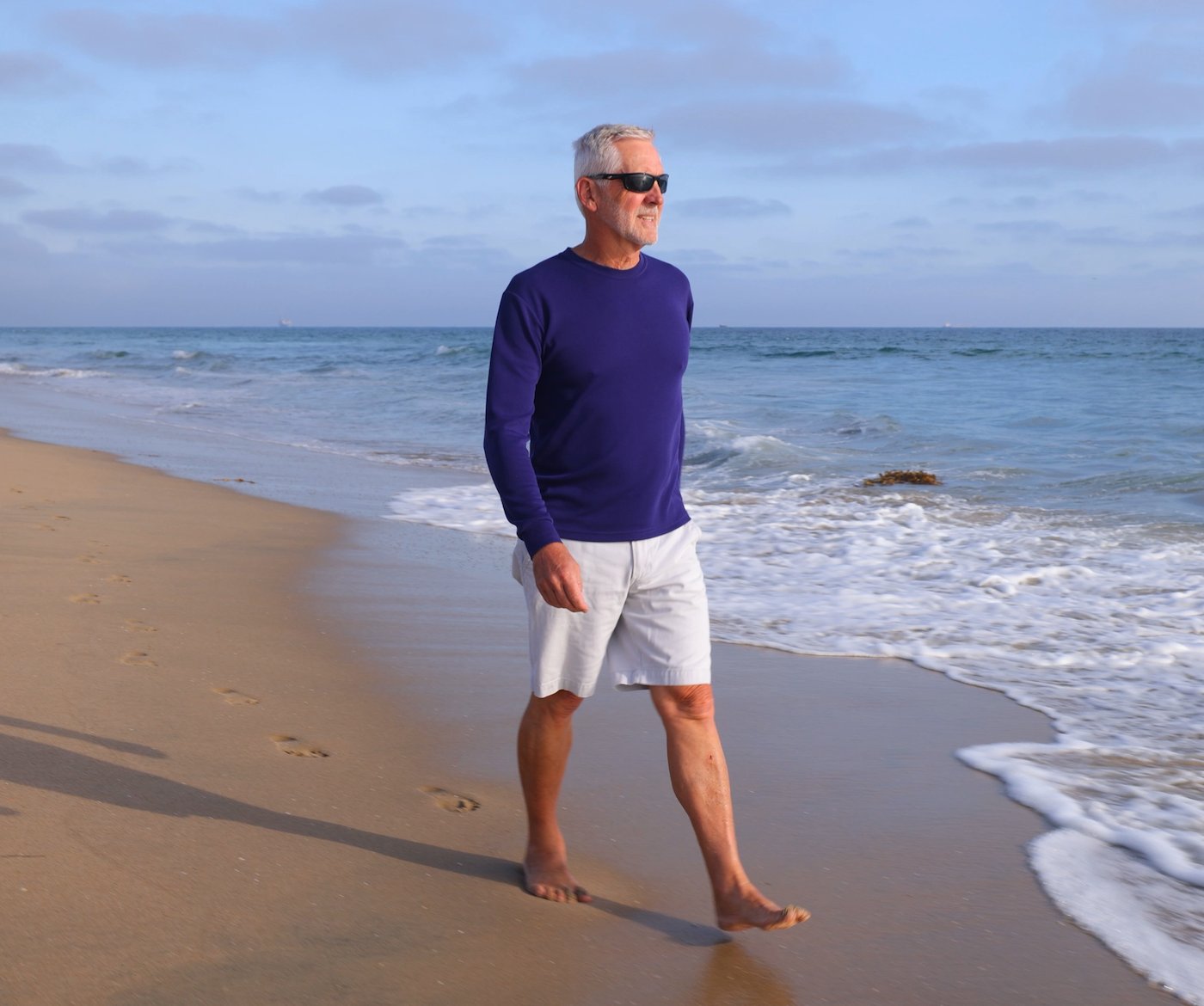
Walking speed for seniors
Learn to build strength and improve balance reactions for a faster walking pace.
 Your walking speed is a strong indicator of your quality of life and future well being.
Your walking speed is a strong indicator of your quality of life and future well being.Did you know seniors who can walk at least three miles per hour are happier, more independent, and live much longer? (1-6). A University of Pittsburgh study on walking speed for seniors found that people in their 70s with a usual walking speed of three mph live about five years longer than people who walk two mph. (1)
The average speed is 2.6 mph for 70s folks who don't need a cane or walker, but three mph is the pace needed to match the average adult walking speed and to cross the street with time to spare at a traffic light (3).
The faster your usual walking pace, the less likely you are to fall and get injured.
Walking speed for seniors: Can you maintain a brisk pace?
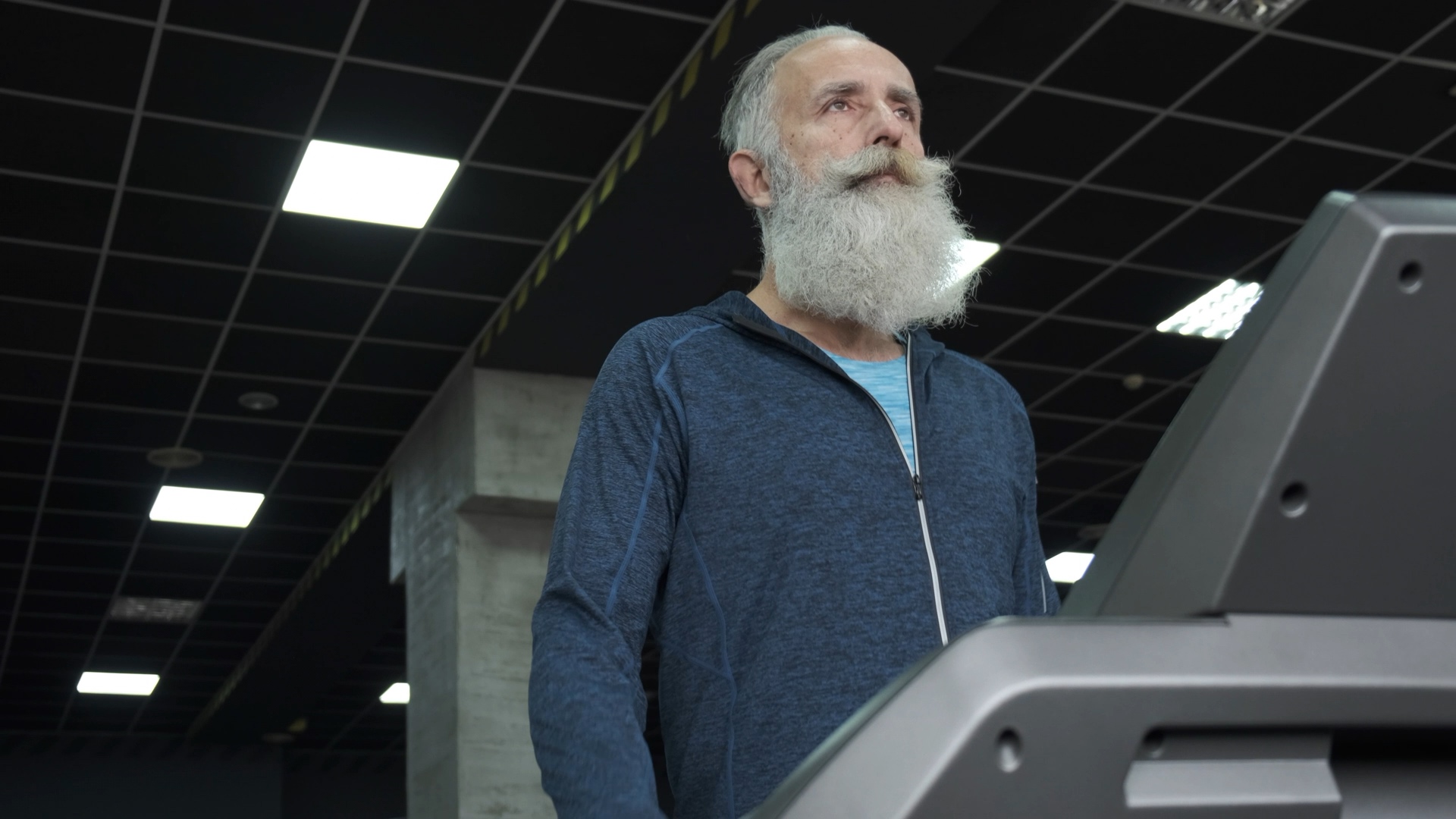 Can you maintain 3 mph for a six-minute walk?
Can you maintain 3 mph for a six-minute walk?A Canadian study found that if you’re fit enough to walk 3 mph for six minutes, you’re much less likely to depend on help from others for your daily needs when compared to a less fit peer (3).
Check with your doctor or health care provider before exercise testing, and have a friend nearby to walk with you if needed. Safety always comes first!
You can test your six-minute walk on a treadmill, a track, or with a fitness watch (on a flat surface). Treadmills make walking a little easier. To simulate outdoor walking, set the treadmill at a 1% grade.
If you’re using a fitness watch, choose a flat route without bumps or busy traffic.
Pre-test warm-up!
Before starting the test, spend a few minutes on range of motion exercises, brief stretching exercises, and light balance drills, such as marching, ankle circles, hip abduction, and knee flexion.
1-2 sets and 10 reps of these movements will help activate your walking muscles and get your circulation going before your walk.
Hold on to support no more than you need to perform a good-quality movement.
See a demo of the warm-up routine in the YouTube video above from Why I Exercise.
Walking speed for seniors: The Six-Minute Walk Test
During the walk, aim for your best safe pace but avoid overstriding. This puts too much stress on your muscles and joints. The better approach is to use your natural stride length and take faster or more frequent steps.
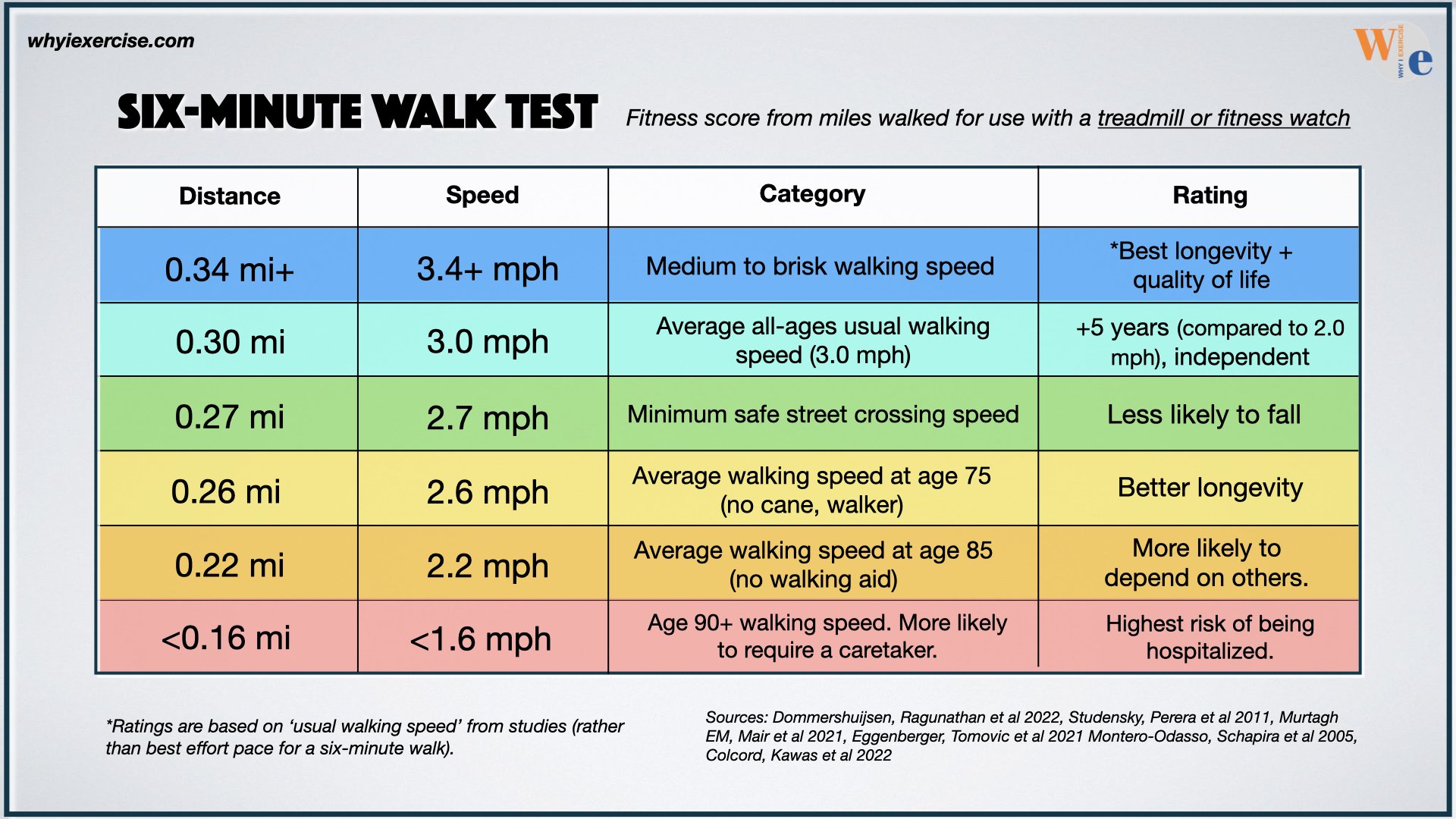 Six-minute walk test results, scored by distance and mph.
Six-minute walk test results, scored by distance and mph.Compare your score to the average walking speed for people who walk without canes, ages 75 and 85. (8)
According to the Pittsburgh study, the faster your walking speed, the better your longevity. They found a significant difference in survival for every improvement of 0.2 miles per hour.
A small improvement can make a meaningful difference wherever you land on the chart.
Walking speed for seniors: How to test yourself on a track!
If you’re using a track, watch for the white lines running across the track, which allow you to gauge your distance. Each major line, as shown, represents 100 meters, and every lap is 400 meters.
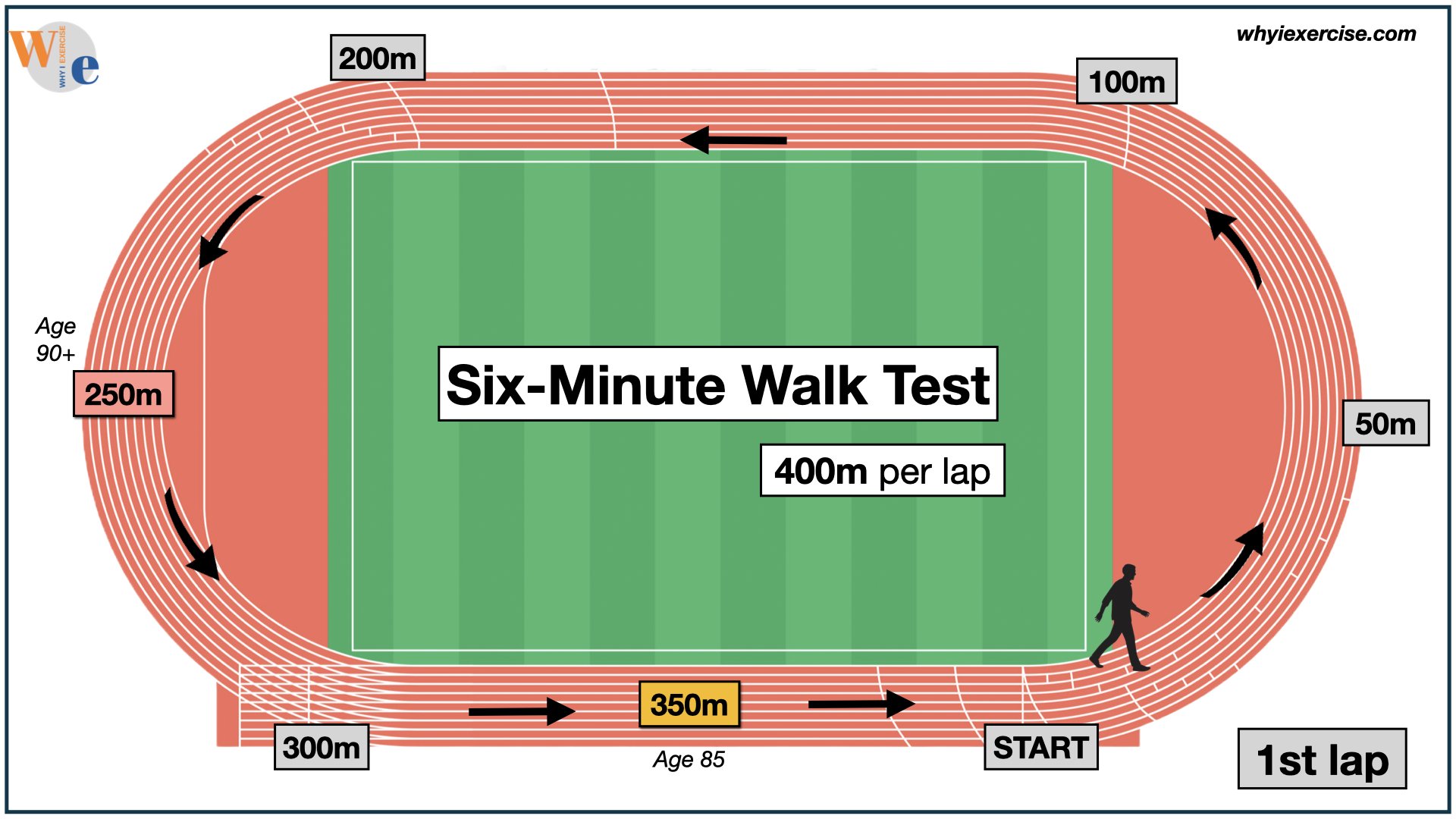 Use these lines on your local track to measure your distance for the six-minute walk.
Use these lines on your local track to measure your distance for the six-minute walk.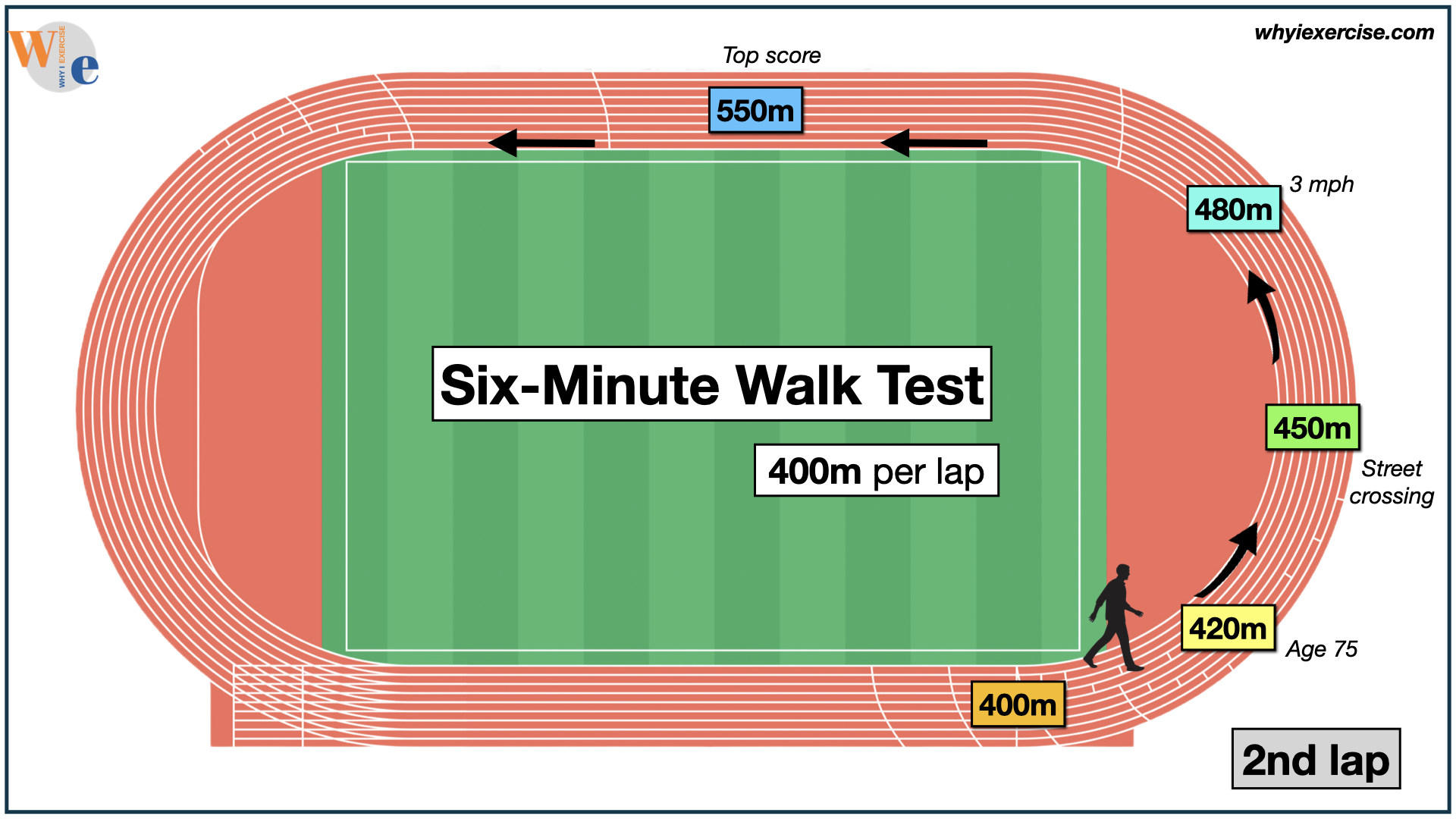 If you can walk more than a lap in 6 minutes, here are the target markers on your second lap to compare your score with.
If you can walk more than a lap in 6 minutes, here are the target markers on your second lap to compare your score with.Pay attention to your watch so you stop right at the six-minute mark. Notice your position on the track when you finish. The first and second markers represent the average pace for 90+ and 85-year-olds (8-9).
The faster your walking pace, the more likely you'll keep an independent lifestyle for the future, and the less likely you are to fall or go to the hospital. The ratings reflect research on the usual walking pace in seniors, so you may want to compare your six-minute speed with your typical walking pace.
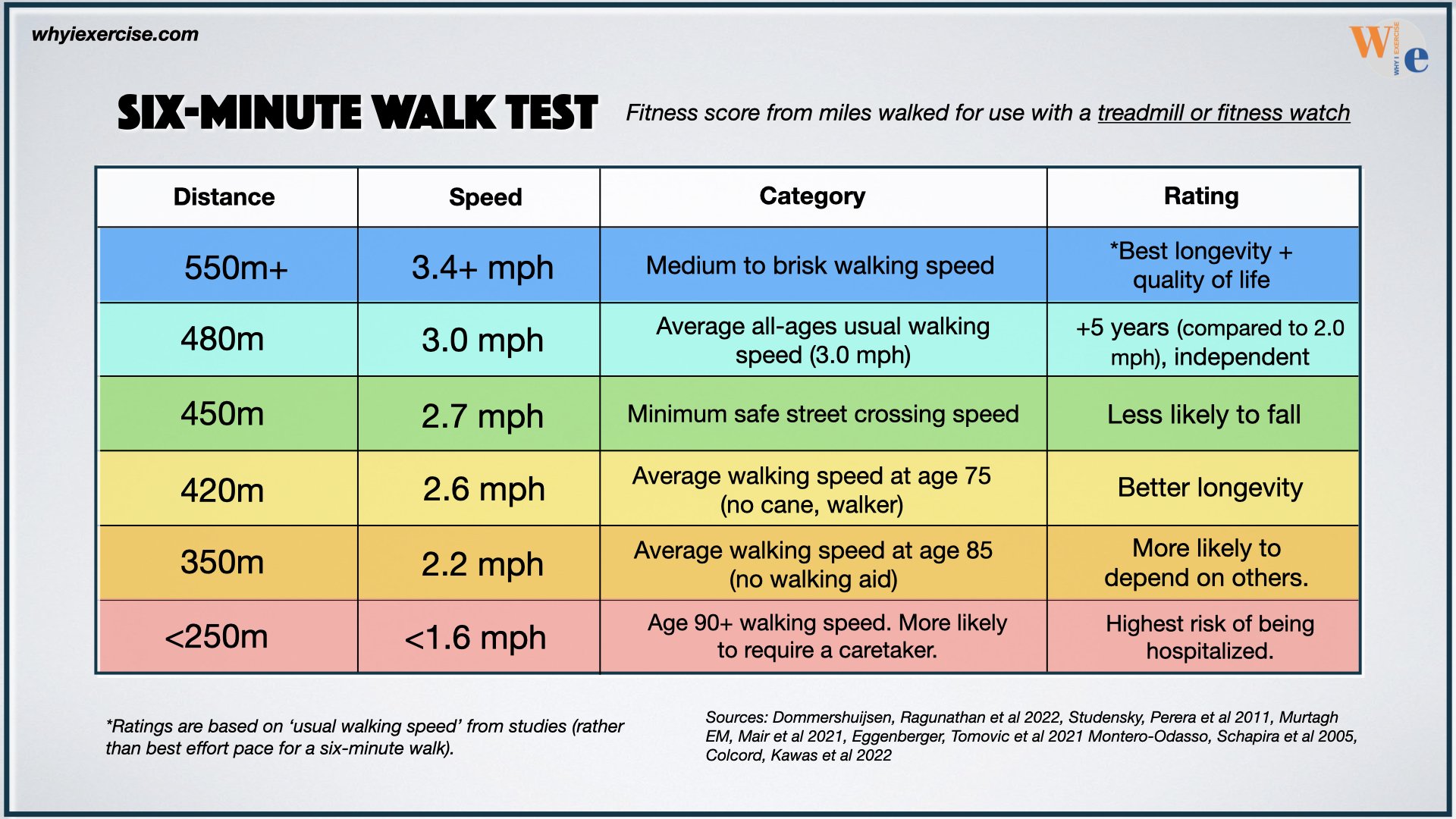 Six-minute walk test scores based on meters.
Six-minute walk test scores based on meters.Walking speed for seniors: Training to improve your pace!
If your score was not where you’d like it to be, know that you aren’t stuck at a slow pace. Studies have found that a slow walking speed can be improved significantly within a few months by building your strength, improving your balance reactions, and gradually spending more time on your feet exercising. (5)
Ankle-weight strengthening and dynamic balance exercises are a good introduction to training. Perform 8-12 reps and 2 sets of standing leg raises (hip flexion, hip abduction and knee flexion) using adjustable ankle weights.
Try starting with 2 lbs and add 1/2 lb at a time as the exercise gets easier. Hold on as needed for balance.
See a demo of the exercises in this YouTube video from Why I Exercise.
2 sets of 8-12 for heel raises and toe taps. Work on increasing your range of motion. For squats and lunges, hold on as needed for balance, adjust the range of motion to your level, and perform 1 set of 8-12 reps.
Cover 15-20 feet and 3-4 reps each for dynamic balance exercises including backward, diagonal and side steps, plus marching with a pause. Increase your distance, pace, and range of motion for the balance exercises as you improve.
Walking speed for seniors: Spend more time on your feet to increase your pace
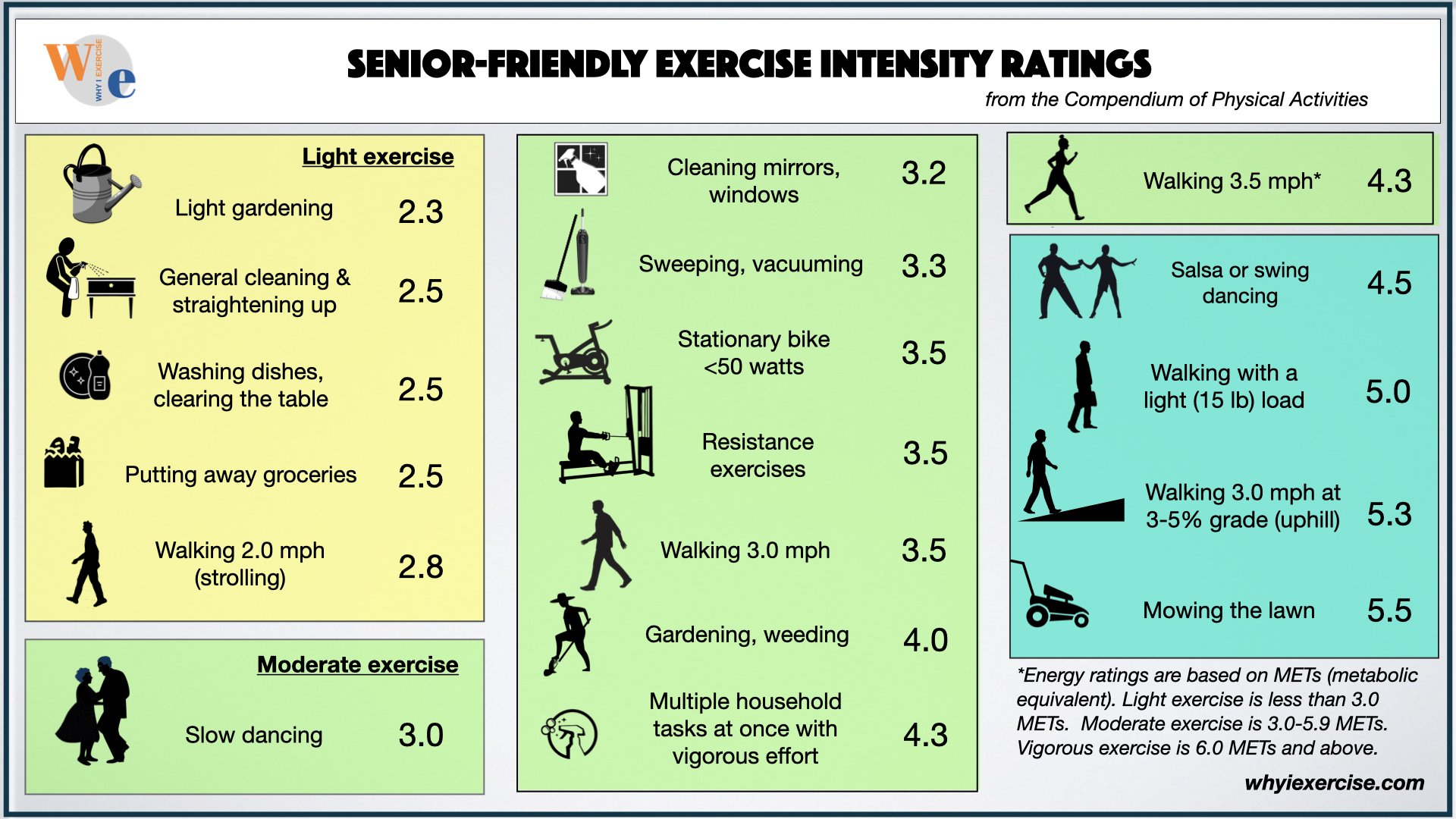 Compare the exercise intensity of these senior-friendly activities with walking speeds of 2.0, 3.0, and 3.5 miles per hour.
Compare the exercise intensity of these senior-friendly activities with walking speeds of 2.0, 3.0, and 3.5 miles per hour.To get more practice time on your feet, add a few minutes to your daily walk and spend more time on activities like those shown on the left.
Exercise builds strength and fitness, whether you spread it throughout the day or do it all at once. To ensure progress, be active enough to challenge yourself consistently. Work toward 150 minutes of moderate exercise per week.
Conclusion
Walking speed is an excellent way to track your overall well-being as a senior, as it's a leading indicator of health and longevity. The average decline in physical ability is aggressive after age 65, and balance declines the fastest, so whether you’re already fit or working on getting there, keep training yourself!
Beginning at age 79 (76 in the US), the average adult spends their last six years with some form of disability, relying on others for their daily needs. Fortunately, the only people who don’t benefit from exercise are the ones who don’t practice.
Get inspiration to stay fit and see the latest science on aging and exercise in the Masterclass article and video below.
More Masterclass articles
Aging and exercise: Have we been aging too quickly?
Exercise and inactivity impact the ways our bodies age. With this in mind, how could (or should) we be aging? You’ll see in-depth, research-based scientific analysis of the aging process, plus inspiring examples of healthy aging.
Age 74 and athletic? Amazing gymnast shares his secrets! (Video)
At age 74, Kim Goodwin is (in many ways) stronger and more athletic than most young adults. He can do over 20 pull-ups, climb a 25-foot rope and perform acrobatic maneuvers on gymnastics rings, among other abilities!
In this video, Kim shows us his skills and shares his story—how he continued getting stronger over so many years!
References
1) Studenski S, Perera S, et al. Gait speed and survival in older adults. JAMA. 2011 Jan 5;305(1):50-8. doi: 10.1001/jama.2010.1923. PMID: 21205966; PMCID: PMC3080184.
2) Ross RM, Murthy JN, et al. The six minute walk test accurately estimates mean peak oxygen uptake. BMC Pulm Med. 2010 May 26;10:31. doi: 10.1186/1471-2466-10-31. PMID: 20504351; PMCID: PMC2882364.
3) Eggenberger P, Tomovic S, et al. Older adults must hurry at pedestrian lights! A cross-sectional analysis of preferred and fast walking speed under single- and dual-task conditions. PLoS One. 2017 Jul 31;12(7):e0182180. doi: 10.1371/journal.pone.0182180. PMID: 28759587; PMCID: PMC5536437.
4) Fritz S, Lusardi M. White paper: "walking speed: the sixth vital sign". J Geriatr Phys Ther. 2009;32(2):46-9. Erratum in: J Geriatr Phys Ther. 2009;32(3):110. PMID: 20039582.
5) Hortobágyi T, Lesinski M, et al Effects of Three Types of Exercise Interventions on Healthy Old Adults' Gait Speed: A Systematic Review and Meta-Analysis. Sports Med. 2015 Dec;45(12):1627-43. doi: 10.1007/s40279-015-0371-2. Erratum in: Sports Med. 2016 Mar;46(3):453. PMID: 26286449; PMCID: PMC4656792.
6) Murtagh EM, Mair JL, Aguiar E, Tudor-Locke C, Murphy MH. Outdoor Walking Speeds of Apparently Healthy Adults: A Systematic Review and Meta-analysis. Sports Med. 2021 Jan;51(1):125-141. doi: 10.1007/s40279-020-01351-3. PMID: 33030707; PMCID: PMC7806575.
7) Montero-Odasso M, Schapira M, et al. Gait velocity as a single predictor of adverse events in healthy seniors aged 75 years and older. J Gerontol A Biol Sci Med Sci. 2005 Oct;60(10):1304-9. doi: 10.1093/gerona/60.10.1304. PMID: 16282564.
8) Dommershuijsen LJ, Ragunathan et al. Gait speed reference values in community-dwelling older adults - Cross-sectional analysis from the Rotterdam Study. Exp Gerontol. 2022 Feb;158:111646. doi: 10.1016/j.exger.2021.111646. Epub 2021 Nov 30. PMID: 34861357.
9) Colcord, Katherine A. PT, DPT; Kawas, Claudia H. MD et al. Gait Speed Reference Values for Adults Aged 90 and Older: The 90+ Study. Journal of Geriatric Physical Therapy ():, February 16, 2022. | DOI: 10.1519/JPT.0000000000000340
10) Shephard RJ. Maximal oxygen intake and independence in old age. Br J Sports Med. 2009 May;43(5):342-6. doi: 10.1136/bjsm.2007.044800. Epub 2008 Apr 10. PMID: 18403414.
